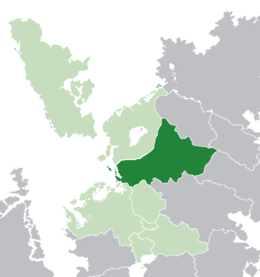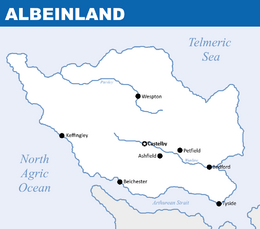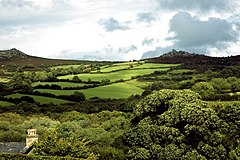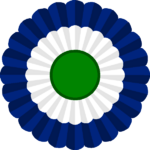Albeinland: Difference between revisions
m (→Geography) |
|||
| Line 96: | Line 96: | ||
[[File:Mont_Blanc_oct_2004.JPG|thumb|left|225px|The Effing Pike is the highest mountain in Albeinland with 4,018 metres]] | [[File:Mont_Blanc_oct_2004.JPG|thumb|left|225px|The Effing Pike is the highest mountain in Albeinland with 4,018 metres]] | ||
Most of the territory is | Most of the territory is composed of the Alban Highlands - a series of plateaus and high terrains that encompass almost all of the Albish soil. The several small mountains and plateaus in the central region up to the coastline ranges from two hundred to four hundred metres in altitude, with Castelby being two hundred and fifty metres above sea level while Eidenburgh and Bedford at three hundred metres above sea level. Despite being at relatively high altitudes for Lorecia, the Albish terrain is not particularly rough, supporting the defence of major cities in mediaeval times and not negatively affecting to a great extext agriculture in the region. The Highlands extends into the Albish coastline, where gradually becomes the Alban Plains in the coastal cities of Lenderpool, Forrest and Sunnaway. | ||
The main rivers in Albeinland are the Kensingley, Ossey and Hammerworth, all of them rising in the Apperlane Mountains and flowing into the Albish Channel. The three rivers and their tributaries are crucial for maintaining the agriculture and industry in Lencester as well as supplying water to the biggest cities of Albeinland. Most of the Albish lakes are located in the province of Bedfordshire in a region known as Lake Lands. The most important lakes within the country are Lake Victoria and Lake Everest, near the Aswickan border. | The main rivers in Albeinland are the Kensingley, Ossey and Hammerworth, all of them rising in the Apperlane Mountains and flowing into the Albish Channel. The three rivers and their tributaries are crucial for maintaining the agriculture and industry in Lencester as well as supplying water to the biggest cities of Albeinland. Most of the Albish lakes are located in the province of Bedfordshire in a region known as Lake Lands. The most important lakes within the country are Lake Victoria and Lake Everest, near the Aswickan border. | ||
Revision as of 23:22, 20 March 2019
Kingdom of Albeinland | |
|---|---|
| Motto: Libertas quæ sera tamen "Liberty albeit late" | |
| Anthem: Albish National Anthem | |
 Albeinland (dark green) in Lorecian Community (light green) | |
 Political map of Albeinland | |
| Capital and largest city | Castelby |
| Official languages | English |
| Ethnic groups (2018) |
|
| Demonym(s) |
|
| Government | Unitary parliamentary constitutional monarchy |
• Monarch | Catherine II |
• Chancellor | Vincent Lloyd |
| Legislature | Parliament |
| House of Commons | |
| House of Lords | |
| Establishment | |
• Foundation of Castelby | 5th century AD |
• Unification | 12 December 1016 |
• Oxford Revolution | 16 August 1652 |
| Area | |
• Total | 1,291,800 km2 (498,800 sq mi) |
| Population | |
• 2019 estimate | 30,969,622 |
• 2018 census | 30,968,221 |
• Density | 23/km2 (59.6/sq mi) |
| GDP (PPP) | 2018 estimate |
• Total | £4.028 trillion |
• Per capita | £29,072 |
| GDP (nominal) | 2018 estimate |
• Total | £5.109 trillion |
• Per capita | £34,011 |
| Gini (2018) | low |
| HDI (2018) | very high |
| Currency | Sterling (£) |
| Time zone | UTC+1 (UTC) |
| Date format | dd-mm-yyyy |
| Driving side | left |
| Calling code | +36 |
Albeinland, officially the Kingdom of Albeinland, is a sovereign state in west Lorecia, sharing borders with Noordenstaat and Fyngaria to the south, Arstotska and Aswick to the northeast and Aurora Confederacy to the northwest. Its territory is composed of the Alban Highlands on the mainland and the islands of Arsey, Brenswick, Brunhill and Lanwel on the Albish Channel. The country has an estimated population of 30 million inhabitants, most of them living in urban spaces such as the capital and largest city, Castelby. Albeinland is a member of the World Assembly since 1991 and is one of the founding states of the Lorecian Community in 1994.
The area that now encompasses Albeinland was settled by Arlethian tribes, an ethnolinguistic group who is conductive to several modern peoples in Lorecia from the 1st century BCE to the 6th century CE. The first Christian missionaries arrived in the 5th century CE and established several churches and monasteries, with local natives and its tribes developing and founding the Kingdom of Anglea, the Kingdom of Cambria and the Duchy of Lencester in the early 7th century. In 1016, after many wars and conflicts, the House of Annesley of Anglea rose to unify the Alban Highlands, with Arthur of Anglea becoming the first sovereign of a united Albeinland. The middle ages were the scene of military conquests which consolidated the Albish state.
Despite the creation of a legislative body in the 14th century, Parliament's minimal jurisdiction and the sovereign's disproportionate authority spawned the first clashes between the two powers, which would only worsen over the years. Most of the Albish population converted to Protestantism in the 16th century, giving to the monarch more powers over Parliament with the creation of the Church of Albeinland. The final spark came in 1663, when the Albish Revolution began and divided the nation between absolutists and constitutionalists. The war ended with a rebel victory and the introduction of a constitutional monarchy in the country. The 17th century was a golden age for national politics, economy and philosophy while the 18th century witnessed the introduction of modern democracy, with universal male suffrage being enacted in 1872 and women's suffrage in 1919.
Today, Albeinland is a developed country operating under a parliamentary constitutional monarchy, with Catherine II acting as monarch and Vincent Lloyd as Chancellor. The country is a member state of the Lorecian Community and the World Assembly.
Etymology
The name "Albeinland" is derived from the Old English Albaland, which means "land of the Albans". The Albans is one of the Arlethic groups who settled the current Albish territory in the 1st century BCE until the christianization of the tribe in the early 7th century. Its earliest recorded use, as Albalanda, comes from a Christian chronicle dated to the 6th century, however, this name has another meaning: "white land" or "white ground". Etymologists believe that the name derives from the harsh winters in the region, causing the Arlethians who settled in the area to begin calling themselves as "the white people".
Neither the Albish Parliament nor Government recognises the gentilics Alban or Albian as wrong, however, the official documents issued by both uses the term Albish only to avoid any historical confusion.
History
Geography
Albeinland has a total area of 1,291,800 square kilometres which its majority is in the Astyrian continent of Lorecia as well as the islands of Arsey, Brenswick, Brunhill and Lanwell on the Albish Channel. The country shares borders with several countries such as Noordenstaat and Fyngaria to the south, Arstotska and Aswick to the northeast and Aurora Confederacy to the northwest, being one of the biggest countries in the Lorecian Community and having borders with at least five countries (excluding naval borders).
The continental landscape of Albeinland comprises of mountainous regions and plateaus. The mountainous region is known as Apperlane Mountains, being mostly centered around the Albish border with Aswick and Fyngaria in the provinces of Cambria and Bedfordhire. Having five mountains with peaks over 1,000 metres, the Effing Pike in southeast Cambria is the highest at 4,018 metres. Due its altitude, the Apperlane Mountains restrains the air flow coming from the ocean and south Lorecia, with the temperature remaining more cold than the Lorecian average.
Most of the territory is composed of the Alban Highlands - a series of plateaus and high terrains that encompass almost all of the Albish soil. The several small mountains and plateaus in the central region up to the coastline ranges from two hundred to four hundred metres in altitude, with Castelby being two hundred and fifty metres above sea level while Eidenburgh and Bedford at three hundred metres above sea level. Despite being at relatively high altitudes for Lorecia, the Albish terrain is not particularly rough, supporting the defence of major cities in mediaeval times and not negatively affecting to a great extext agriculture in the region. The Highlands extends into the Albish coastline, where gradually becomes the Alban Plains in the coastal cities of Lenderpool, Forrest and Sunnaway.
The main rivers in Albeinland are the Kensingley, Ossey and Hammerworth, all of them rising in the Apperlane Mountains and flowing into the Albish Channel. The three rivers and their tributaries are crucial for maintaining the agriculture and industry in Lencester as well as supplying water to the biggest cities of Albeinland. Most of the Albish lakes are located in the province of Bedfordshire in a region known as Lake Lands. The most important lakes within the country are Lake Victoria and Lake Everest, near the Aswickan border.
Climate

Albeinland is considered one of the coldest countries in Lorecia, with an average temperature varying between -2°C to -15°C in the winters and 5°C to 18°C in the summers. The coldest months are December and January, while June and July are the hottest. According to the Köppen climate classification, about 40% of the Albish territory has a cool temperate climate with stiffer winters and mild summers, with cities such as Castelby, Bedford, Eidenburgh and Rosefort suffering snowstorms in the winters and having a cool climate in the summers followed by a transitional humid continental climate between the coastline and countryside. The Albish coast has an oceanic climate with mild winters and warmer summers.
In the more mountainous regions located near the borders, the tundra biome predominates, with the temperature remaining below zero almost all year. Since the Alverville Observatory began to record the weather, the highest temperature ever recorded was 37°C on August 2007 in Hampsey and the coldest temperature being -41°C in Pendston on March 1994.
Biodiversity
The fauna and flora of Albeinland shares many species in common with other Lorecian countries; however, it has a number of unique animals and plants. There is a large number of oaks and pines in its forested areas, with oaks being distributed more in the coastal and central zones with the pines in the colder regions. In terms of fauna, the country has a series of small and medium-sized birds and mammals such as Arseyan wrens, red squirrels, foxes and ferrets.








